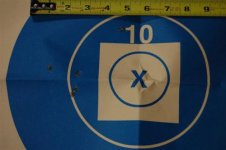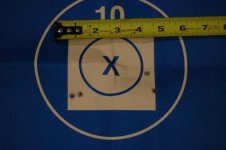Gentlemen:
The attached is why I measure powder of all loads at all distances. The 2nd sheet identifies the particulars about the rifle used. I used a Hart Accuracey Asset to turn my hunting rifle into a "bench" rifle. Bullets were either 52 grn moly coated match Bergers or 55 grn Hornady moly coated V-max's straight from the box. I have no idea what the seating depth was, but I suspect it was around 0.025 off the lands. (these targets were shot over 10 years ago before I became "enlightened" about the importance of seating depth) Charges were weighed with an RCBS electronic scale of the period ($200 or so). I have no idea what the model number was, as I inadvertently toasted it one day and pitched it into the round file.
The top target (1st sheet of 6 smaller targets) shows what happens to a "bughole", 5 shot group with a 0.1 grain incremntal powder increase. I always chrono everything I shoot (Oehler 35P), but can't find the assocciated data sheet. However, target #6 shows what can happen with an obviously "different" velocity. I have no idea why there was a 250 fps bust, other than "operator error" (ya gotta pay attention to the winkin' blinkin' lights)
The bottom target (2nd, lower sheet) shows what happens with 3-shot groups with a 0.3 grain incremental powder increase. (I'll get to the significance of that powder increment directly) There are two items of note:
1) the 3 shot groups really aren't that bad considering my skill level and equipment. I have no idea how a true short range benchrester would asses some of them in deciding whether or not to keep the load and use it in a match, but targets 4, 5, and 6 look pretty good to me.
2) notice how the
center of the group significantly shifts around based on powder charge. The most noticeable shift also occurs among targets 4, 5, and 6, the ones indicative of "the" load. Now consider what any group would look like if there was a 0.3 grain bust (say from 35.7 to 36.0, or 36.0 to 36.3) in the powder weight. Poster child ugly.... (typically associated with most of my range efforts)
I have a Harrell measure. At the time, my typical "extreme spread" of powder measuring was (you guessed it) 0.3 grains, no matter how much "bumpin', grindin" and holdin' ma jaw right". I believe static electricity is the primary culprit in preventing consistent powder throwing. (when kernels adhere to the case mouth, "cosmic forces" are involved

)
For short range (200 yards or less), I believe velocity variations (however anyone wants to portray them) are sidebar issues. Boyd Allen had what I believe is an an excellent point: what is the "pulse" in the system, in terms of velocity, that produces the best accuracy? Knowing that velocity is very beneficial in recapturing accuracy when components change.
I have no experience with a 6 PPC. However, I have done considerable testing with other cases trying to identify powders that the system "likes". I do this by loading 5 cases of a selected powder at 1.0 grain increments (that's correct, no typo, mine's bigger than yours....

) with bullets just touching the lands. I then shoot all 5 at one target at 100 yards to see how they "group". The powder associated with the preferred group then gets selected for actual load development. I've had one instance where a 5 grain powder weight spread produced a group in the 2's. I've had several in the 3's, and, as you can imagine, a good many of them had measurements associated with that nefarious oriental fellow Yu Flung Dung. The point is that there are some systems, coupled with a specific case, that seem to fall in love with a particular powder and primer combination. I suspect that the 6 PPC is very forgiving in that regard....up to a point. Otherwise the short range bunch wouldn't be moving heaven and earth to buy 14 tons of some esoteric powder produced only on February 30th. If you should happen to be stuck with a powder that your system tends to tolerate instead of "like", then weighing powder, as indicated by the attachment, could become a key step for achieving consistent, competitive accuracy.
For those of you wondering "who in blazes is Scott Fletcher?", I am an infidel 1000 yard benchrester. "It's the same.....only differnet"

Scott



